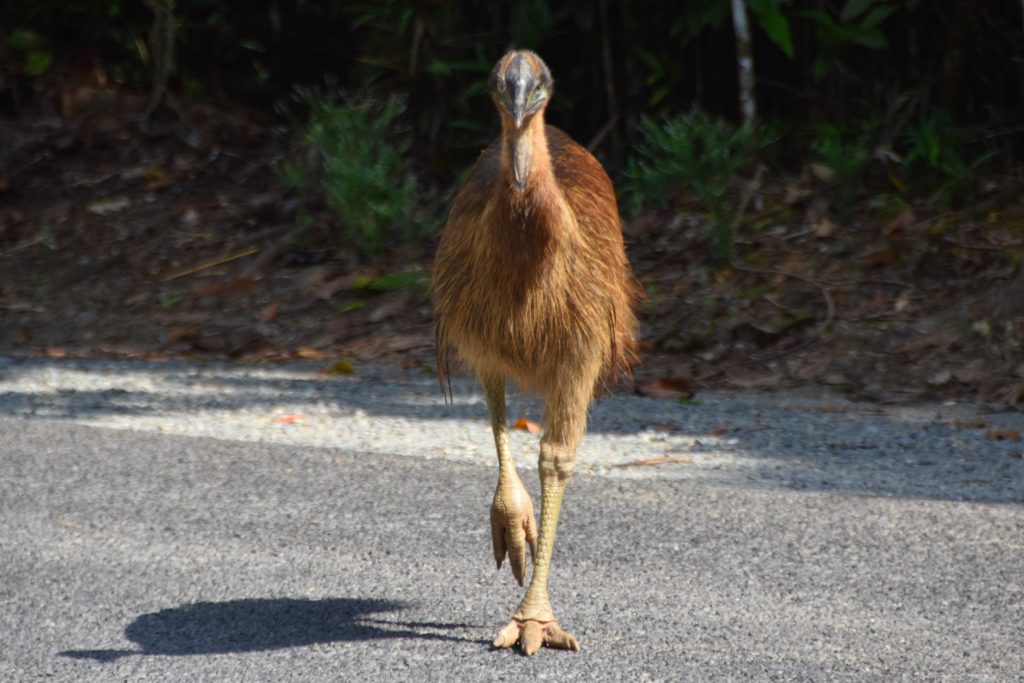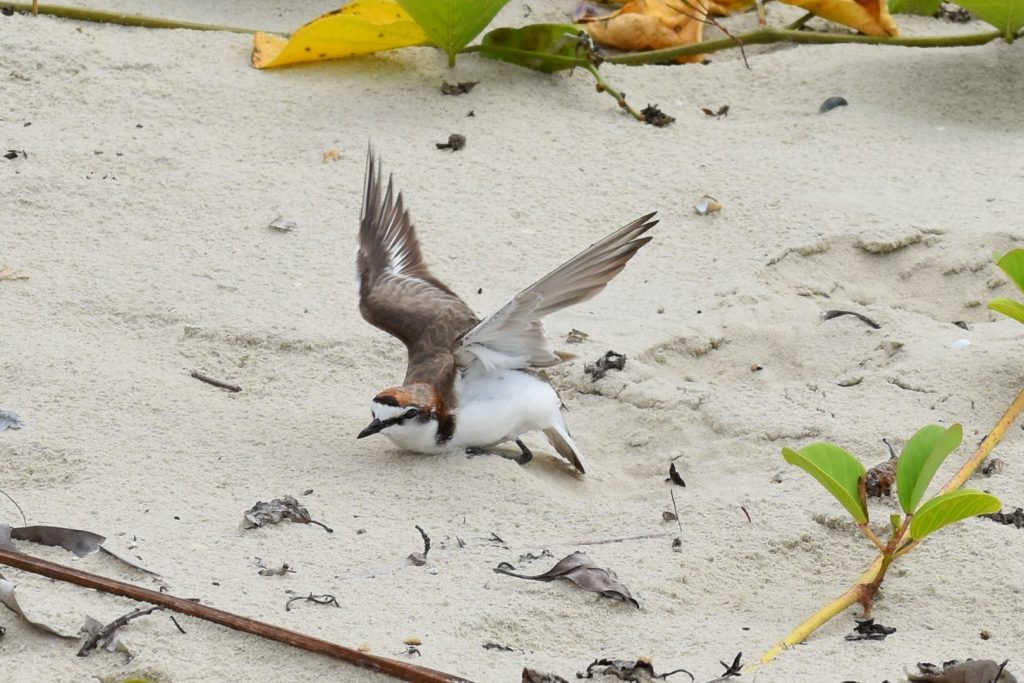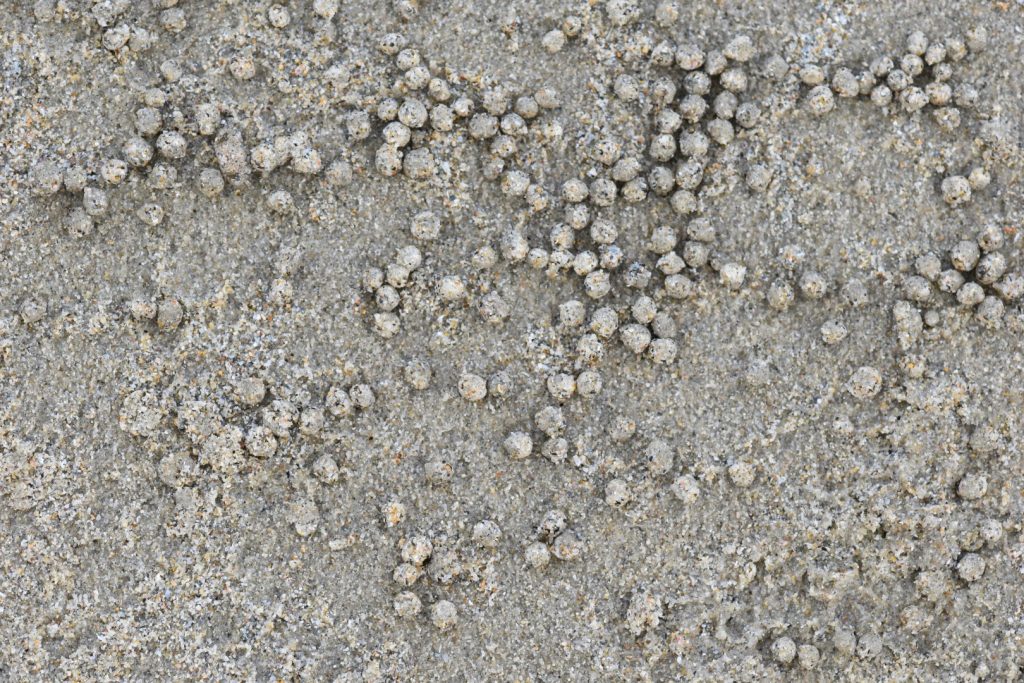The Daintree rain forests are filled with life of all shapes and sizes and as the forest is so productive some of the animals can be quite large like these Cassowaries. Cassowaries live predominantly on a diet of fruit and the fruit around here is so plentiful, everywhere you walk there are fruits and berries of all shapes and colours scattered on the ground.
Male cassowaries hatch the eggs and raise the young chicks and this young one looks about ready to be out on it’s own as it’s plumage is starting to darken to the adult colours, everything I’ve read about them says to be very cautious, especially of the males when they have young with them.
So when this young one started wandering towards me I backed away behind the car, not that the adult male showed any sign of being agitated. They both seemed completely unconcerned by the people gathering to take photos. I walked up a small walking trail from down at a river and they were wandering towards me along the main road, cars had stopped behind them and everyone was out with their cameras.
Finally, I’d been here for about 8-9 days by this stage and I’d only seen a quick flash of a cassowary disappearing into the bush. While these guys were just owning the place, as they should.
After casually wandering down the road they meandered over the bridge in no hurry, stopping the traffic in both direction. There were about half a dozen of us following them along taking photos as they went about their business.
This poor bird was on the beach must have had a nest near by on the beach somewhere, it was trying to distract me with all sorts of squawking and strange poses holding it’s wings up, laying on it’s side almost rolling completely over.
There are many birds through the forest, especially common, are what I’ve been calling the “jungle chickens”. I saw at least 3 species of these “jungle chickens”, from the bare necked freaky chickens I’d first seen back near Innesfail, which were also all around the campsite here at Cape Tribulation, through to smaller darker ones which were more timid scratching through the leaf litter on the floor of the jungle.
Evidently this is called an Emerald ground dove, I never saw any on the ground though this one had been sitting on a branch over a small creek that I’d wandered past and photographed quite a few times though I had never seen the bird during my previous walks as it’s well camouflaged and sat dead still. I can see why it’s a dove, that poor excuse for a nest which all doves seem to make.
The mangroves are also a diverse and productive area. A superficial look might leave you imagining that they’re just smelly lifeless swamps but as always, when you stop, look and listen carefully you start to see life everywhere.
I thought this was a photo of just one crab and as I was going to post it on the blog I figured that it needed cropping down to better show the crab specimen. But as you look closer at the picture you can see there are more. I managed to count 7 crabs in the picture, click on the image to blow it up and see if you can spot them all.
Speaking of crabs, this led me to my next discovery on the reefs along the beach, yay, finally I’d found some shells, but they were all gathered together in a group in the one spot. Then once again as I looked closer, there was some movement.
It was a gathering of crabs in shells, well many had crabs in them, some of them were empty, I wondered if this was some kind of meeting and shell exchange point. As each crab grows they need to change shells many times over their lives and as shells seemed to be in relatively short supply, it would seem to make sense that these “shell exchange” places would build up over time, drop your old shell, get into a new bigger one.
As I looked more closely there were a few of these little gatherings of shells and crabs, they seemed to be grouped by size. Here you can see a few little groups of different sized shells and crabs.
Big ones up the top of the picture, average size bottom right and right near the bottom on the right there are much smaller ones, all grouped together, all had some crabs in them and some empty shells. Interesting stuff postulating on why these things are as they are, I certainly realized that I can’t be taking any shells from around this area, it’s also going to make me far more cautious in the future. Only shell grit from open beaches where there’s masses of it and they aren’t needed as they are here.
This is the home and feeding ground of a sand bubbler crab, they come out of their holes at low tide gathering the sand up and removing tiny bits of algae and food from the grains of sand, they form it up in a ball as they are doing this, then discard the balls of cleaned sand behind them. Most of the beaches up here are thick with them but they can be very hard to spot the actual crab, they are extremely quick and will disappear down their holes when you get near. You often see them shooting down their holes as you walk along the beach, but even those which get caught out in the open are extremely hard to see, can you spot this one.
How about if I zoom into the top left corner of the photo.
OK, this one you don’t get any hints as to where it’s hiding.
Mud skippers were also in abundance in the more protected areas where fresh water streams flowed into the ocean.
These crazy little fish don’t seem to like going into the water, they sit right on the edge of the water and they’ll skip along the sand at the waters edge if you disturb them. If they have nowhere to go, they jump across the surface of deep water to get to the other sandy edge. Tide movements are large and a great time for watching fish in the ocean as well I saw many varieties of fish and small stingrays in the shallows as the tides were moving.
Green tree ants are everywhere up here, within 24 hours of arriving and setting up my awning they had climbed the guy ropes and colonized the awning and the outside of my caravan. In this photo they are attacking a large earwig on one of my ropes and although it took them a long time they eventually won.
When they build their nests the ants pull together leaves of a tree, they band together pulling it tighter and holding it in place while other ants get their larvae and hold the larvae up using the silk they expel to bind together their leaves holding them in place. Talk about child labour.
Here you see a couple of ants trying to pull leaves together and the white silk binding the other leaves of their nest.
There are a vast array of spiders through the jungle, from the barely visible through to the highly visible and in your face kind of spider, often quite literally “in your face” while you’re walking. This is a barely visible one, with just a small web over the surface of the one leaf.
While this one was a bit more “in your face”.




















No Comments